Frank Ong
OMuleT: Orchestrating Multiple Tools for Practicable Conversational Recommendation
Nov 28, 2024



Abstract:In this paper, we present a systematic effort to design, evaluate, and implement a realistic conversational recommender system (CRS). The objective of our system is to allow users to input free-form text to request recommendations, and then receive a list of relevant and diverse items. While previous work on synthetic queries augments large language models (LLMs) with 1-3 tools, we argue that a more extensive toolbox is necessary to effectively handle real user requests. As such, we propose a novel approach that equips LLMs with over 10 tools, providing them access to the internal knowledge base and API calls used in production. We evaluate our model on a dataset of real users and show that it generates relevant, novel, and diverse recommendations compared to vanilla LLMs. Furthermore, we conduct ablation studies to demonstrate the effectiveness of using the full range of tools in our toolbox. We share our designs and lessons learned from deploying the system for internal alpha release. Our contribution is the addressing of all four key aspects of a practicable CRS: (1) real user requests, (2) augmenting LLMs with a wide variety of tools, (3) extensive evaluation, and (4) deployment insights.
Coil Sketching for computationally-efficient MR iterative reconstruction
May 10, 2023Abstract:Purpose: Parallel imaging and compressed sensing reconstructions of large MRI datasets often have a prohibitive computational cost that bottlenecks clinical deployment, especially for 3D non-Cartesian acquisitions. One common approach is to reduce the number of coil channels actively used during reconstruction as in coil compression. While effective for Cartesian imaging, coil compression inherently loses signal energy, producing shading artifacts that compromise image quality for 3D non-Cartesian imaging. We propose coil sketching, a general and versatile method for computationally-efficient iterative MR image reconstruction. Theory and Methods: We based our method on randomized sketching algorithms, a type of large-scale optimization algorithms well established in the fields of machine learning and big data analysis. We adapt the sketching theory to the MRI reconstruction problem via a structured sketching matrix that, similar to coil compression, reduces the number of coils concurrently used during reconstruction, but unlike coil compression, is able to leverage energy from all coils. Results: First, we performed ablation experiments to validate the sketching matrix design on both Cartesian and non-Cartesian datasets. The resulting design yielded both improved computational efficiency and preserved signal-to-noise ratio (SNR) as measured by the inverse g-factor. Then, we verified the efficacy of our approach on high-dimensional non-Cartesian 3D cones datasets, where coil sketching yielded up to three-fold faster reconstructions with equivalent image quality. Conclusion: Coil sketching is a general and versatile reconstruction framework for computationally fast and memory-efficient reconstruction.
SUREMap: Predicting Uncertainty in CNN-based Image Reconstruction Using Stein's Unbiased Risk Estimate
Oct 25, 2020



Abstract:Convolutional neural networks (CNN) have emerged as a powerful tool for solving computational imaging reconstruction problems. However, CNNs are generally difficult-to-understand black-boxes. Accordingly, it is challenging to know when they will work and, more importantly, when they will fail. This limitation is a major barrier to their use in safety-critical applications like medical imaging: Is that blob in the reconstruction an artifact or a tumor? In this work we use Stein's unbiased risk estimate (SURE) to develop per-pixel confidence intervals, in the form of heatmaps, for compressive sensing reconstruction using the approximate message passing (AMP) framework with CNN-based denoisers. These heatmaps tell end-users how much to trust an image formed by a CNN, which could greatly improve the utility of CNNs in various computational imaging applications.
Spectral Decomposition in Deep Networks for Segmentation of Dynamic Medical Images
Sep 30, 2020
Abstract:Dynamic contrast-enhanced magnetic resonance imaging (DCE- MRI) is a widely used multi-phase technique routinely used in clinical practice. DCE and similar datasets of dynamic medical data tend to contain redundant information on the spatial and temporal components that may not be relevant for detection of the object of interest and result in unnecessarily complex computer models with long training times that may also under-perform at test time due to the abundance of noisy heterogeneous data. This work attempts to increase the training efficacy and performance of deep networks by determining redundant information in the spatial and spectral components and show that the performance of segmentation accuracy can be maintained and potentially improved. Reported experiments include the evaluation of training/testing efficacy on a heterogeneous dataset composed of abdominal images of pediatric DCE patients, showing that drastic data reduction (higher than 80%) can preserve the dynamic information and performance of the segmentation model, while effectively suppressing noise and unwanted portion of the images.
Unsupervised MRI Reconstruction with Generative Adversarial Networks
Aug 29, 2020



Abstract:Deep learning-based image reconstruction methods have achieved promising results across multiple MRI applications. However, most approaches require large-scale fully-sampled ground truth data for supervised training. Acquiring fully-sampled data is often either difficult or impossible, particularly for dynamic contrast enhancement (DCE), 3D cardiac cine, and 4D flow. We present a deep learning framework for MRI reconstruction without any fully-sampled data using generative adversarial networks. We test the proposed method in two scenarios: retrospectively undersampled fast spin echo knee exams and prospectively undersampled abdominal DCE. The method recovers more anatomical structure compared to conventional methods.
Reconstruction of Undersampled 3D Non-Cartesian Image-Based Navigators for Coronary MRA Using an Unrolled Deep Learning Model
Oct 24, 2019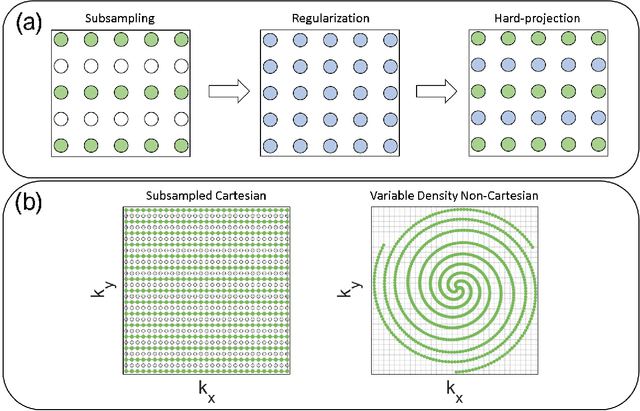

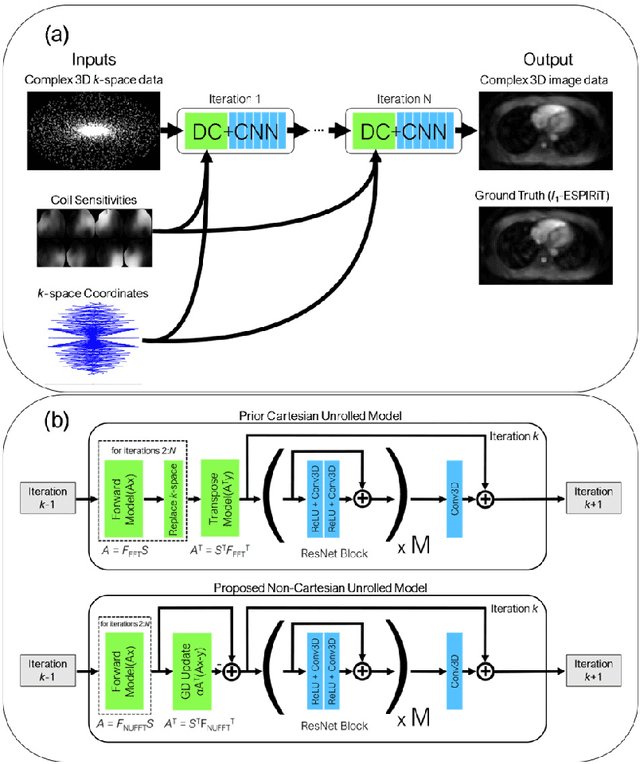
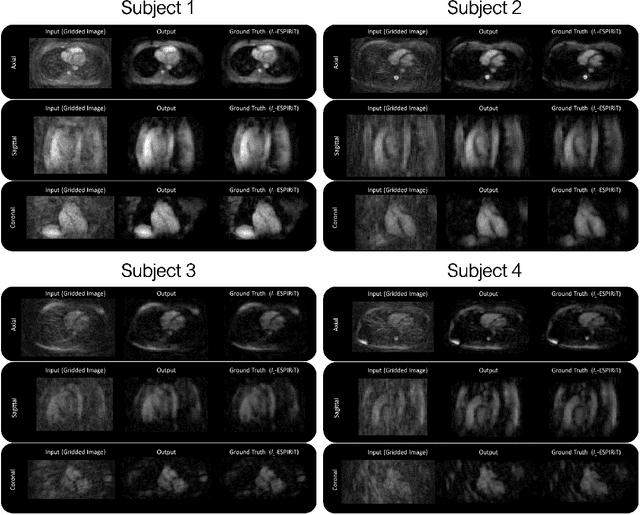
Abstract:Purpose: To rapidly reconstruct undersampled 3D non-Cartesian image-based navigators (iNAVs) using an unrolled deep learning (DL) model for non-rigid motion correction in coronary magnetic resonance angiography (CMRA). Methods: An unrolled network is trained to reconstruct beat-to-beat 3D iNAVs acquired as part of a CMRA sequence. The unrolled model incorporates a non-uniform FFT operator to perform the data consistency operation, and the regularization term is learned by a convolutional neural network (CNN) based on the proximal gradient descent algorithm. The training set includes 6,000 3D iNAVs acquired from 7 different subjects and 11 scans using a variable-density (VD) cones trajectory. For testing, 3D iNAVs from 4 additional subjects are reconstructed using the unrolled model. To validate reconstruction accuracy, global and localized motion estimates from DL model-based 3D iNAVs are compared with those extracted from 3D iNAVs reconstructed with $\textit{l}_{1}$-ESPIRiT. Then, the high-resolution coronary MRA images motion corrected with autofocusing using the $\textit{l}_{1}$-ESPIRiT and DL model-based 3D iNAVs are assessed for differences. Results: 3D iNAVs reconstructed using the DL model-based approach and conventional $\textit{l}_{1}$-ESPIRiT generate similar global and localized motion estimates and provide equivalent coronary image quality. Reconstruction with the unrolled network completes in a fraction of the time compared to CPU and GPU implementations of $\textit{l}_{1}$-ESPIRiT (20x and 3x speed increases, respectively). Conclusion: We have developed a deep neural network architecture to reconstruct undersampled 3D non-Cartesian VD cones iNAVs. Our approach decreases reconstruction time for 3D iNAVs, while preserving the accuracy of non-rigid motion information offered by them for correction.
Local Kernels that Approximate Bayesian Regularization and Proximal Operators
Mar 09, 2018



Abstract:In this work, we broadly connect kernel-based filtering (e.g. approaches such as the bilateral filters and nonlocal means, but also many more) with general variational formulations of Bayesian regularized least squares, and the related concept of proximal operators. The latter set of variational/Bayesian/proximal formulations often result in optimization problems that do not have closed-form solutions, and therefore typically require global iterative solutions. Our main contribution here is to establish how one can approximate the solution of the resulting global optimization problems with use of locally adaptive filters with specific kernels. Our results are valid for small regularization strength but the approach is powerful enough to be useful for a wide range of applications because we expose how to derive a "kernelized" solution to these problems that approximates the global solution in one-shot, using only local operations. As another side benefit in the reverse direction, given a local data-adaptive filter constructed with a particular choice of kernel, we enable the interpretation of such filters in the variational/Bayesian/proximal framework.
BLADE: Filter Learning for General Purpose Computational Photography
Dec 07, 2017



Abstract:The Rapid and Accurate Image Super Resolution (RAISR) method of Romano, Isidoro, and Milanfar is a computationally efficient image upscaling method using a trained set of filters. We describe a generalization of RAISR, which we name Best Linear Adaptive Enhancement (BLADE). This approach is a trainable edge-adaptive filtering framework that is general, simple, computationally efficient, and useful for a wide range of problems in computational photography. We show applications to operations which may appear in a camera pipeline including denoising, demosaicing, and stylization.
General Phase Regularized Reconstruction using Phase Cycling
Sep 15, 2017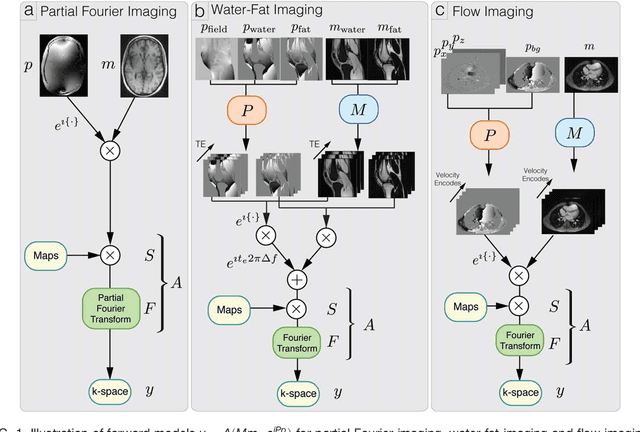
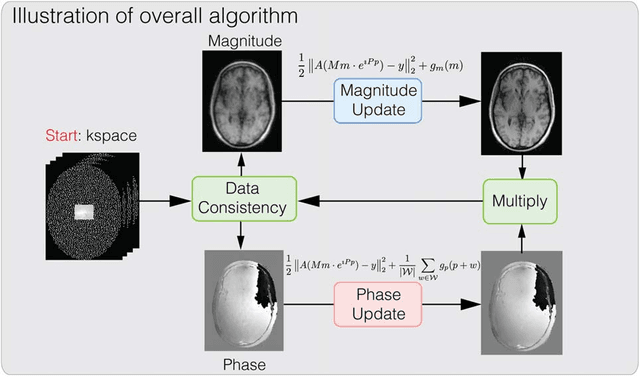
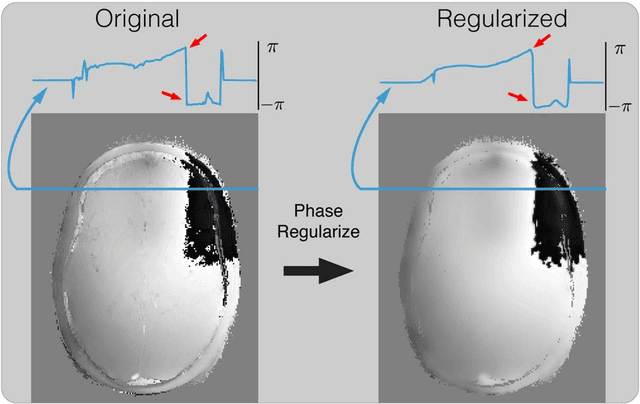
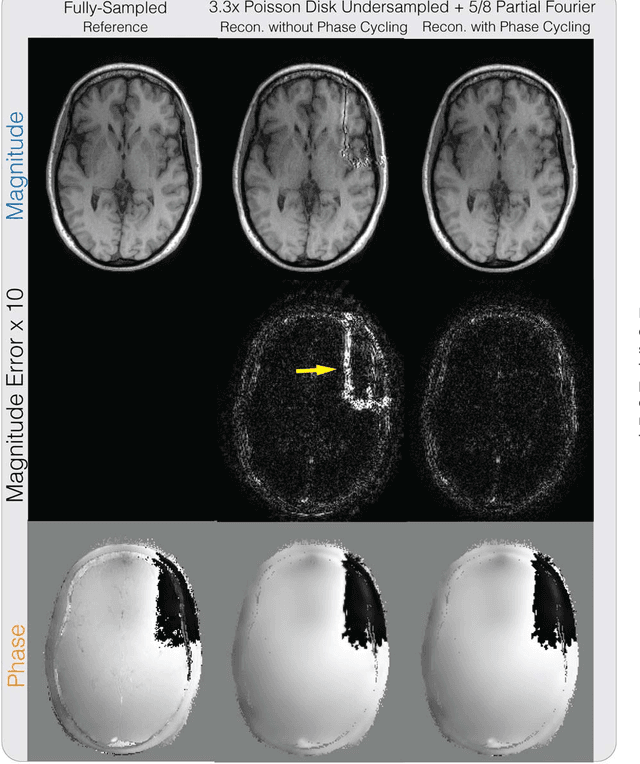
Abstract:Purpose: To develop a general phase regularized image reconstruction method, with applications to partial Fourier imaging, water-fat imaging and flow imaging. Theory and Methods: The problem of enforcing phase constraints in reconstruction was studied under a regularized inverse problem framework. A general phase regularized reconstruction algorithm was proposed to enable various joint reconstruction of partial Fourier imaging, water-fat imaging and flow imaging, along with parallel imaging (PI) and compressed sensing (CS). Since phase regularized reconstruction is inherently non-convex and sensitive to phase wraps in the initial solution, a reconstruction technique, named phase cycling, was proposed to render the overall algorithm invariant to phase wraps. The proposed method was applied to retrospectively under-sampled in vivo datasets and compared with state of the art reconstruction methods. Results: Phase cycling reconstructions showed reduction of artifacts compared to reconstructions with- out phase cycling and achieved similar performances as state of the art results in partial Fourier, water-fat and divergence-free regularized flow reconstruction. Joint reconstruction of partial Fourier + water-fat imaging + PI + CS, and partial Fourier + divergence-free regularized flow imaging + PI + CS were demonstrated. Conclusion: The proposed phase cycling reconstruction provides an alternative way to perform phase regularized reconstruction, without the need to perform phase unwrapping. It is robust to the choice of initial solutions and encourages the joint reconstruction of phase imaging applications.
 Add to Chrome
Add to Chrome Add to Firefox
Add to Firefox Add to Edge
Add to Edge